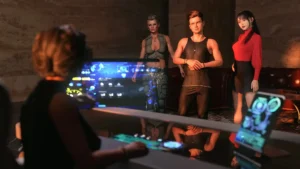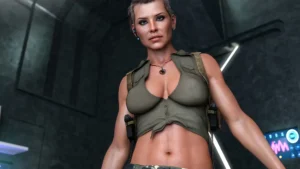
How to Fix the Future
Play How to Fix the Future
How to Fix the Future review
Master the sci-fi interactive adventure with deep choices, stunning visuals, and immersive storytelling
If you’re curious about How to Fix the Future, you’re not alone—this sci-fi interactive adventure has captivated players with its blend of everyday drama and high-stakes time-travel missions. You step into the shoes of an ordinary guy whose life takes a wild turn when mysterious agents from the future recruit him to alter the course of history. Along the way, you’ll navigate complex relationships, make tough decisions, and experience a story where every choice ripples across time. Whether you’re here for the narrative depth, the visual polish, or the blend of strategy and emotion, this guide will help you get the most out of your journey through How to Fix the Future.
What Is How to Fix the Future? Story, Setting, and Premise
Ever find yourself staring at the clock at your day job, wondering if this is really all there is? 🙃 You push papers, attend meetings that could have been emails, and dream of something more. Now, imagine getting a tap on the shoulder from the future, telling you that you’re the only one who can prevent a global catastrophe. That’s the electrifying premise of How to Fix the Future, a game that grabs you by the collar of your boring work shirt and throws you headfirst into an adventure.
This isn’t just another sci-fi romp. The How to Fix the Future story is a masterclass in contrast, making you feel the weight of your ordinary life and the dizzying heights of your extraordinary secret. One moment, you’re worrying about your quarterly sales report; the next, you’re deciphering encrypted messages about a timeline-altering event. It’s this emotional whiplash that makes the experience so profoundly personal and immersive. You don’t just play a hero; you become a person who chooses to be one, despite the terrifying risks to your comfortable, predictable world.
A Dual Life: Mundane Reality Meets Sci-Fi Adventure 🕵️♂️
The core of this experience is the genius dual life gameplay. You live two lives simultaneously, and the game makes you feel the strain and the thrill of both. By day, you are utterly unremarkable. You might be a junior data analyst named Alex, stuck in a cubicle farm under the flickering glow of fluorescent lights. Your biggest concerns are your boss’s mood, making rent, and whether you have enough milk for your morning coffee. ☕
Then, the message comes. A discreet notification on a device no one else can see. Suddenly, you’re Agent “Cipher,” a crucial operative for a clandestine organization from the future. Your mission: to subtly alter key events in the present to steer humanity away from a dystopian collapse. The transition is never easy. I remember one session where I spent ten in-game minutes carefully placating a difficult customer on the phone, only to immediately have to make a split-second decision that would determine the fate of a major political figure. The whiplash is real, and it’s brilliant.
This sci-fi visual novel format is the perfect vehicle for this concept. The stunning artwork shifts seamlessly from the drab, beige tones of your office to the sleek, neon-drenched holographic interfaces of your secret mission. The interactive storytelling forces you to constantly juggle your two identities. Do you leave work early to follow a lead, risking your job and your cover? Or do you play it safe, potentially missing a crucial window to alter the future?
Here’s a glimpse into the stark divide you’ll be navigating:
| Your Mundane Daily Life 😴 | Your Secret Mission Activities 🚀 |
|---|---|
| Attending soul-crushing team-building seminars | Infiltrating a high-tech corporate gala |
| Arguing with your landlord about the leaking faucet | Decrypting files that reveal a global conspiracy |
| Trying to remember your coworker’s kid’s name | Deciding whether to trust a mysterious informant |
| Budgeting for groceries for the week | Allocating resources to prevent an energy crisis |
Meet the Characters: Relationships That Matter ❤️🔥
What truly elevates the How to Fix the Future story beyond a simple spy thriller is its profound focus on character relationships. Every person you meet, from your nosy cubicle neighbor to the enigmatic leader of the future agents, is a fully realized individual with their own dreams, fears, and secrets.
Your choices don’t just affect the mission; they deeply affect your personal connections. This is where the game’s emotional choices truly shine. You might be tasked with getting close to a charismatic tech CEO for information, only to find yourself genuinely liking them. Do you betray their trust for the greater good, or do you find another way, potentially jeopardizing the entire future agents mission?
The cast is incredibly diverse. You have:
* Jenna, your pragmatic and fiercely loyal best friend from the office, who just wants you to be happy and might start suspecting you’re hiding something.
* Kai, your handler from the future, cool and collected but with a hidden vulnerability that makes you question their motives.
* Dr. Aris, the brilliant but morally ambiguous scientist you’re supposed to monitor, whose passion for discovery is both admirable and terrifying.
* Mark, your seemingly simple-minded roommate, whose unwavering support becomes an unexpected anchor in your chaotic double life.
The game masterfully tracks your interactions, and the character relationships evolve organically. A kind word during someone’s moment of doubt can unlock entirely new branches of dialogue and support later on, while a careless dismissal can close doors permanently.
Pro Tip: Always listen, I mean really listen, to what the characters are saying. The key to strengthening character relationships often lies in remembering a small, personal detail they mentioned earlier and bringing it up when they least expect it.
Let me give you an example of how a simple choice can ripple outwards. Imagine a scene where your coworker, Lena, is crying in the breakroom after a fight with her partner.
- Choice 1: “I’m sure it will blow over. Do you need help with the TPS reports?” (Professional, but distant)
- Choice 2: “Hey, forget the reports. Do you want to talk about it? I’m a good listener.” (Personal, empathetic)
If you choose option 2, you learn that her partner is involved with a controversial bio-tech firm. This isn’t just a nice moment; it becomes critical intelligence for your future agents mission hours later. The game constantly reminds you that emotional choices are never just fluff; they are the very fabric of the narrative and your success.
The Core Mystery: Why Were You Chosen? 🔍
As you get deeper into the future agents mission, one question will gnaw at you more than any other: Why you? 🤔 You’re not a decorated soldier, a genius physicist, or a master hacker. You’re… well, you. This central mystery is the engine of the entire How to Fix the Future story.
The organization from the future, often communicating through Kai, is cryptic. They talk about “temporal inertia,” “butterfly effects,” and “unobserved variables.” They chose you not despite your ordinariness, but because of it. Major historical figures are too “visible” in the timeline; their actions are too closely watched and have too many predictable outcomes. You, the unobserved, the seemingly insignificant, have a unique power to create change without triggering alarms.
But can you trust them? This is a core tension of the interactive storytelling. Are you a valued partner, or are you a pawn in a much larger game you don’t understand? I had a moment of pure paranoia where I realized a piece of advice from Kai, if followed, would have inadvertently caused harm to someone I cared about in my personal life. Was it a test? A mistake? Or deliberate?
The stunning sci-fi visual novel presentation amplifies this mystery. Close-up shots of characters’ faces make you search their eyes for the truth. The environments in the “mission” segments are filled with cryptic symbols and foreshadowing. The sound design—a subtle shift in the musical score, an almost imperceptible electronic hum—constantly keeps you on edge, questioning everything.
Unraveling the “why” is a personal journey. You’ll uncover fragments of the truth through:
* Hidden data logs within your mission interfaces.
* Off-hand comments from characters in both of your lives.
* The consequences of your own emotional choices.
The How to Fix the Future story is, at its heart, a story about finding your own significance. It argues that heroism isn’t about being born special; it’s about what you do when presented with a choice. It’s about the courage to step out of your comfortable, mundane reality and embrace the terrifying, wonderful responsibility of shaping tomorrow. And that is a story that will stay with you long after you’ve put the controller down. ✨
How to Fix the Future stands out as a sci-fi interactive adventure that blends relatable everyday struggles with the thrill of time-altering missions. Its rich narrative, meaningful choices, and striking visuals create an experience that’s both emotionally engaging and strategically rewarding. Whether you’re drawn to its story, its characters, or the challenge of shaping the future, there’s plenty to discover—and every playthrough can feel uniquely your own. Ready to start your journey? Dive in, make your mark on the timeline, and see how your choices reshape the world. Share your stories and join the community to see what futures others have created.




















